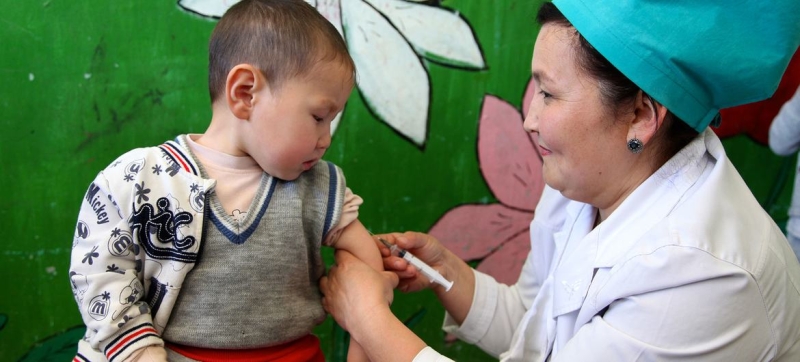
.6.5 million children have not received the third dose of DPT vaccine, which is needed to protect against disease in infancy and early childhood. In the photo: a clinic in Kyrgyzstan New WHO data on immunization: 35 million children worldwide are not protected from measles Healthcare
Last year, 2.7 million more children were not vaccinated or did not receive the required number of doses of vaccinations compared to pre-pandemic levels. This is evidenced by new global data published by the World Health Organization (WHO) and the United Nations Children’s Fund (UNICEF).
It is estimated that nearly 75 percent of infants live in countries where low vaccination coverage leads to measles outbreaks.
Global Coverage
The proportion of children receiving three doses of diphtheria, tetanus and pertussis (DTP) vaccine, a key indicator of immunization status, remained at 84 percent (108 million) in 2023, the data showed. However, the number of children who have not received a single dose of vaccine increased from 13.9 million in 2022 to 14.5 million in 2023.
In addition, 6, 5 million children have not received the third dose of DPT vaccine, which is needed to protect against diseases in infancy and early childhood.
Global immunization coverage has remained virtually unchanged since 2022 and what else more worryingly, it has still not returned to 2019 levels. This situation reflects ongoing challenges related to disruptions in health services, logistical difficulties, vaccine hesitancy, and inequalities in access to services.
Measles outbreaks
WHO and UNICEF data also show that nearly 35 million children remain unvaccinated against measles or have not received the required number of doses.
In 2023, only 83 percent of children worldwide received first dose of measles vaccine as part of basic health services, while the proportion of children receiving the second dose increased slightly from the previous year, reaching 74 percent. These numbers are far from the 95 percent needed to prevent measles outbreaks and deaths.
Read also:
Measles incidence is increasing in Europe
Over the past five years, a surge in cases has hit 103 countries, home to about three-quarters of the world’s babies. Low vaccination coverage (80 percent or less) was a major factor in the outbreaks. In contrast, 91 countries with high measles vaccination rates experienced no outbreaks.
“This problem can be solved. Measles vaccination is cheap and can be delivered to even the most difficult to reach places,” said WHO Director-General Tedros Adhanom Ghebreyesus.
HPV vaccination
The new data also shows some positive trends. New and underutilized vaccines continue to be introduced, including against human papillomavirus (HPV), meningitis, pneumococcal disease, polio and rotavirus, particularly in the 57 countries supported by the Global Alliance for Vaccines and Immunization (GAVI).
The proportion of adolescent girls worldwide who have received at least one dose of the HPV vaccine, which protects against cervical cancer, has increased from 20 percent in 2022 to 27 percent percent in 2023. This was largely due to strong GAVI efforts in developing countries, including Bangladesh, Indonesia and Nigeria.
However, HPV vaccination coverage is still well below the 90 percent target. achievement of which is necessary to eliminate cervical cancer as a public health problem. However, 56 percent of adolescent girls in high-income countries have received the vaccine, and 23 percent in low- and middle-income countries.
